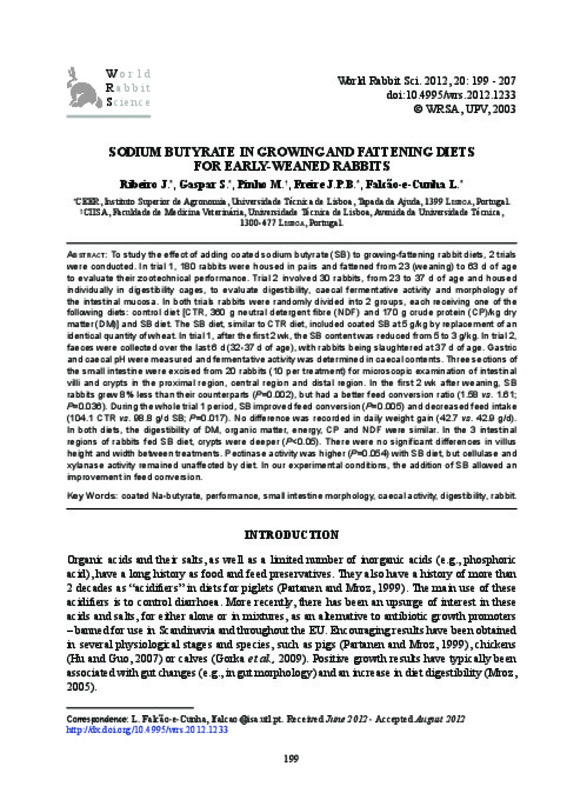JavaScript is disabled for your browser. Some features of this site may not work without it.
Buscar en RiuNet
Listar
Mi cuenta
Estadísticas
Ayuda RiuNet
Admin. UPV
Sodium butyrate in growing and fattening diets for early-weaned rabbits
Mostrar el registro sencillo del ítem
Ficheros en el ítem
| dc.contributor.author | Ribeiro, Joana
|
es_ES |
| dc.contributor.author | Gaspar, Sandra
|
es_ES |
| dc.contributor.author | Pinho, Mário
|
es_ES |
| dc.contributor.author | Freire, João P. B.
|
es_ES |
| dc.contributor.author | Falcão-e-Cunha, Luisa
|
es_ES |
| dc.date.accessioned | 2013-01-09T12:37:50Z | |
| dc.date.issued | 2012-12-28 | |
| dc.identifier.issn | 1257-5011 | |
| dc.identifier.uri | http://hdl.handle.net/10251/18354 | |
| dc.description.abstract | [EN] To study the effect of adding coated sodium butyrate (SB) to growing-fattening rabbit diets, 2 trials were conducted. In trial 1, 180 rabbits were housed in pairs and fattened from 23 (weaning) to 63 d of age to evaluate their zootechnical performance. Trial 2 involved 30 rabbits, from 23 to 37 d of age and housed individually in digestibility cages, to evaluate digestibility, caecal fermentative activity and morphology of the intestinal mucosa. In both trials rabbits were randomly divided into 2 groups, each receiving one of the following diets: control diet [CTR, 360 g neutral detergent fibre (NDF) and 170 g crude protein (CP)/kg dry matter (DM)] and SB diet. The SB diet, similar to CTR diet, included coated SB at 5 g/kg by replacement of an identical quantity of wheat. In trial 1, after the first 2 wk, the SB content was reduced from 5 to 3 g/kg. In trial 2, faeces were collected over the last 6 d (32-37 d of age), with rabbits being slaughtered at 37 d of age. Gastric and caecal pH were measured and fermentative activity was determined in caecal contents. Three sections of the small intestine were excised from 20 rabbits (10 per treatment) for microscopic examination of intestinal villi and crypts in the proximal region, central region and distal region. In the first 2 wk after weaning, SB rabbits grew 8% less than their counterparts (P=0.002), but had a better feed conversion ratio (1.58 vs. 1.61; P=0.036). During the whole trial 1 period, SB improved feed conversion (P=0.005) and decreased feed intake (104.1 CTR vs. 98.8 g/d SB; P=0.017). No difference was recorded in daily weight gain (42.7 vs. 42.9 g/d). In both diets, the digestibility of DM, organic matter, energy, CP and NDF were similar. In the 3 intestinal regions of rabbits fed SB diet, crypts were deeper (P<0.05). There were no significant differences in villus height and width between treatments. Pectinase activity was higher (P=0.054) with SB diet, but cellulase and xylanase activity remained unaffected by diet. In our experimental conditions, the addition of SB allowed an improvement in feed conversion. | es_ES |
| dc.language | Inglés | es_ES |
| dc.publisher | Editorial Universitat Politècnica de València | es_ES |
| dc.relation.ispartof | World Rabbit Science | |
| dc.rights | Reserva de todos los derechos | es_ES |
| dc.subject | Coated na-butyrate | es_ES |
| dc.subject | Performance | es_ES |
| dc.subject | Small intestine morphology | es_ES |
| dc.subject | Caecal activity | es_ES |
| dc.subject | Digestibility | es_ES |
| dc.subject | Rabbit | es_ES |
| dc.title | Sodium butyrate in growing and fattening diets for early-weaned rabbits | es_ES |
| dc.type | Artículo | es_ES |
| dc.date.updated | 2013-01-09T11:03:12Z | |
| dc.identifier.doi | 10.4995/wrs.2012.1233 | |
| dc.rights.accessRights | Abierto | es_ES |
| dc.description.bibliographicCitation | Ribeiro, J.; Gaspar, S.; Pinho, M.; Freire, JPB.; Falcão-E-Cunha, L. (2012). Sodium butyrate in growing and fattening diets for early-weaned rabbits. World Rabbit Science. 20(4):199-207. https://doi.org/10.4995/wrs.2012.1233 | es_ES |
| dc.description.accrualMethod | SWORD | es_ES |
| dc.relation.publisherversion | https://doi.org/10.4995/wrs.2012.1233 | |
| dc.description.upvformatpinicio | 199 | |
| dc.description.upvformatpfin | 207 | |
| dc.description.volume | 20 | |
| dc.description.issue | 4 | |
| dc.identifier.eissn | 1989-8886 |








